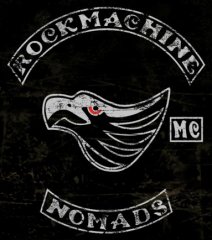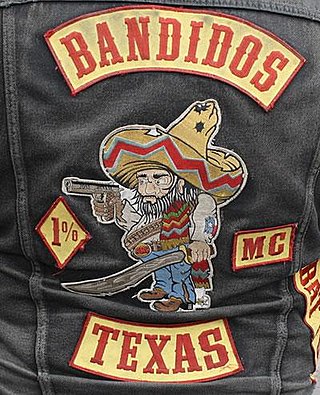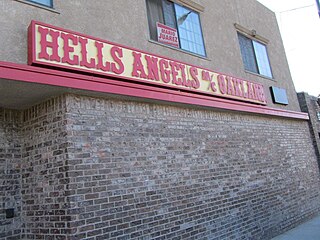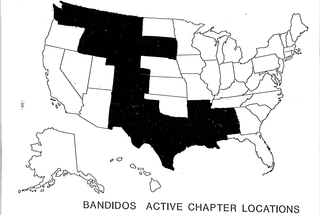
The Rock Machine Motorcycle Club (RMMC) or Rock Machine is an international outlaw motorcycle club founded in Montreal, Quebec, Canada in 1986. It has eighteen Canadian chapters spread across seven provinces. It also has nine chapters in the United States and eleven chapters in Australia, with chapters also located in 24 other countries worldwide. It was formed in 1986, by Salvatore Cazzetta and his brother Giovanni Cazzetta. The Rock Machine competed with the Hells Angels for control of the street-level narcotics trade in Quebec. The Quebec Biker War saw the Rock Machine form an alliance with a number of other organizations to face the Hells Angels. The conflict occurred between 1994 and 2002 and resulted in over 160 deaths and over 300 injured. An additional 100+ have been imprisoned.

Ralph Hubert "Sonny" Barger Jr. was an American outlaw biker who was a founding member of the Oakland, California chapter of the Hells Angels Motorcycle Club in 1957. After forming the Oakland chapter, Barger was instrumental in unifying various disparate Hells Angels chapters and had the club incorporated in 1966. He emerged as the Hells Angels' most prominent member during the counterculture era and was reputed by law enforcement and media to be the club's international president, an allegation he repeatedly denied. The author Hunter S. Thompson called Barger "the Maximum Leader" of the Hells Angels, and Philip Martin of the Phoenix New Times described him as "the archetypical Hells Angel", saying he "didn't found the motorcycle club ... but he constructed the myth". Barger authored five books, and appeared on television and in film.

Pagan's Motorcycle Club, or simply the Pagans, is an outlaw motorcycle club formed by Lou Dobkin in 1957 in Prince George's County, Maryland, United States. The club rapidly expanded and by 1959, the Pagans, originally clad in blue denim jackets and riding Triumphs, began to evolve along the lines of the stereotypical one percenter motorcycle club.

The Diablos Motorcycle Club is an outlaw motorcycle club founded in San Bernardino, California in 1961 that has chapters in cities across the United States.

The Sons of Silence Motorcycle Club (SOSMC) is an international outlaw motorcycle club. Founded in Niwot, Colorado in the United States in 1966, the club has a membership of over 250, with 35 chapters based in 12 U.S. states and in Germany. The Sons of Silence are the sixth-largest motorcycle club in the world, behind the Hells Angels, the Bandidos, the Outlaws, the Pagans and the Mongols.

The Warlocks Motorcycle Club, also distinguished as the Harpy Warlocks or the Philly Warlocks, is an American outlaw motorcycle club that was formed in Philadelphia in 1967. The club is most prominent in the Delaware Valley, including Philadelphia, Delaware County and South Jersey, as well as in the nearby Lehigh Valley.

Numerous police and international intelligence agencies classify the Hells Angels Motorcycle Club (HAMC) as a motorcycle gang and contend that members carry out widespread violent crimes, including drug dealing, trafficking in stolen goods, gunrunning, extortion, and human trafficking operations. Members of the organization have continuously asserted that they are only a group of motorcycle enthusiasts who have joined to ride motorcycles together, to organize social events such as group road trips, fundraisers, parties, and motorcycle rallies, and that any crimes are the responsibility of the individuals who carried them out and not the club as a whole. Members of the club have been accused of crimes and/or convicted in many host nations.

The Bacchus Motorcycle Club (BMC) is an Outlaw motorcycle club in Canada. Founded during 1972 in Albert County, New Brunswick. Bacchus MC has since increased its influence, opening fifteen chapters in five Canadian provinces. It is currently the third largest Canadian established 1% motorcycle club.

The Bandidos Motorcycle Club is classified as a motorcycle gang by law enforcement and intelligence agencies in numerous countries. While the club has denied being a criminal organization, Bandidos members have been convicted of partaking in criminal enterprises including theft, extortion, prostitution, drug trafficking and murder in various host nations.

The Cannonball Motorcycle Club (CMC) is an outlaw motorcycle club in Finland and Estonia. Founded in Helsinki in 1991, the club has eleven chapters and a membership of over two-hundred. Cannonball MC is designated as an organized crime group by the National Bureau of Investigation (NBI).

The Wheels of Soul Motorcycle Club are a multiracial one-percenter outlaw motorcycle club. Although they are active nationwide in the United States, they are primarily based in Philadelphia, Pennsylvania. With chapters in at least 25 states across the US, the group claims to be the country's largest mixed-race outlaw motorcycle club.

The Sin City Deciples Motorcycle Club, also known as Sin City Nation, is a mixed race one-percenter outlaw motorcycle club. As one of the most well-known and oldest black outlaw motorcycle clubs in the United States, they have multiple chapters across the nation and have an additional presence in Canada, Europe, Asia, Australia, and South America. Additionally, the organization has many support clubs in across the U.S. in select states.

Numerous police and international intelligence agencies classify the Hells Angels Motorcycle Club as a motorcycle gang and contend that members carry out widespread violent crimes, including drug dealing, trafficking in stolen goods, gunrunning, extortion, and prostitution rings. Members of the organization have continuously asserted that they are only a group of motorcycle enthusiasts who have joined to ride motorcycles together, to organize social events such as group road trips, fundraisers, parties, and motorcycle rallies, and that any crimes are the responsibility of the individuals who carried them out and not the club as a whole.

The Dirty Dozen Motorcycle Club (DDMC) was an outlaw motorcycle club in Arizona. Founded in 1964, the Dirty Dozen became the preeminent motorcycle gang in the state, and ultimately merged with the Hells Angels in 1997.

The Hells Angels Motorcycle Club (HAMC) is designated an outlaw motorcycle gang by the Department of Justice. Based primarily in the Southwest, the Pacific Northwest, the Great Lakes region, the Mid-Atlantic and New England, there are an estimated 92 Hells Angels chapters in 27 U.S. states, with a membership of over 800. Due to the club's designation as a "known criminal organization" by the State Department and Department of Homeland Security, the United States has a federal policy prohibiting its foreign members from entering the country. The Hells Angels partake in drug trafficking, gunrunning, extortion, money laundering, insurance fraud, kidnapping, robbery, theft, counterfeiting, contraband smuggling, loan sharking, prostitution, trafficking in stolen goods, motorcycle and motorcycle parts theft, assault, murder, bombings, arson, intimidation and contract killing. The club's role in the narcotics trade involves the production, transportation and distribution of marijuana and methamphetamine, in addition to the transportation and distribution of cocaine, hashish, heroin, LSD, MDMA, PCP and diverted pharmaceuticals. According to the Federal Bureau of Investigation (FBI), the HAMC may earn up to $1 billion in drug sales annually.

The Bandidos Motorcycle Club has been designated an outlaw motorcycle gang by the U.S. Department of Justice. The club is involved in drug trafficking, weapons trafficking, prostitution, money laundering, explosives violations, motorcycle and motorcycle-parts theft, intimidation, insurance fraud, kidnapping, robbery, theft, stolen property, counterfeiting, contraband smuggling, murder, bombings, extortion, arson and assault. The Bandidos partake in transporting and distributing cocaine and marijuana, and the production, transportation and distribution of methamphetamine. Active primarily in the Northwestern, Southeastern, Southwestern and the West Central regions, there are an estimated 800 to 1,000 Bandidos members and 93 chapters in 16 U.S. states.

The Mongols Motorcycle Club is considered a motorcycle gang by law enforcement and intelligence agencies in various countries internationally. Mongols members have a long history in the illegal drugs trade, money laundering, robbery, extortion, firearms violations, murder, and assault, among other crimes. However, senior Mongols members as well as attorneys for the club deny that the group as a whole is a criminal enterprise and claim that the Mongols' bylaws prohibit criminals and drug users from being members.

The Outlaws Motorcycle Club, also known as the American Outlaws Association, or A.O.A., is classified as a motorcycle gang by various law enforcement agencies internationally. The Outlaws have been implicated in various organized crime activities, including drug trafficking, extortion, money laundering, prostitution rings, weapons trafficking, and violent acts directed at rival motorcycle clubs. Members of the Outlaws have continuously denied that the club is an organized crime syndicate, asserted that the organization is simply a group of motorcycle enthusiasts who live a nonconventional lifestyle, and described allegations by investigators and prosecutors as exaggerated.
Numerous police and international intelligence agencies classify the Hells Angels Motorcycle Club (HAMC) as a motorcycle gang and contend that members carry out widespread violent crimes, including drug dealing, trafficking in stolen goods, gunrunning, extortion, and prostitution rings. Members of the organization have continuously asserted that they are only a group of motorcycle enthusiasts who have joined to ride motorcycles together, to organize social events such as group road trips, fundraisers, parties, and motorcycle rallies, and that any crimes are the responsibility of the individuals who carried them out and not the club as a whole.
Numerous police and international intelligence agencies classify the Hells Angels Motorcycle Club (HAMC) as a motorcycle gang and contend that members carry out widespread violent crimes, including drug dealing, trafficking in stolen goods, gunrunning, extortion, and prostitution rings. Members of the organization have continuously asserted that they are only a group of motorcycle enthusiasts who have joined to ride motorcycles together, to organize social events such as group road trips, fundraisers, parties, and motorcycle rallies, and that any crimes are the responsibility of the individuals who carried them out and not the club as a whole.


















